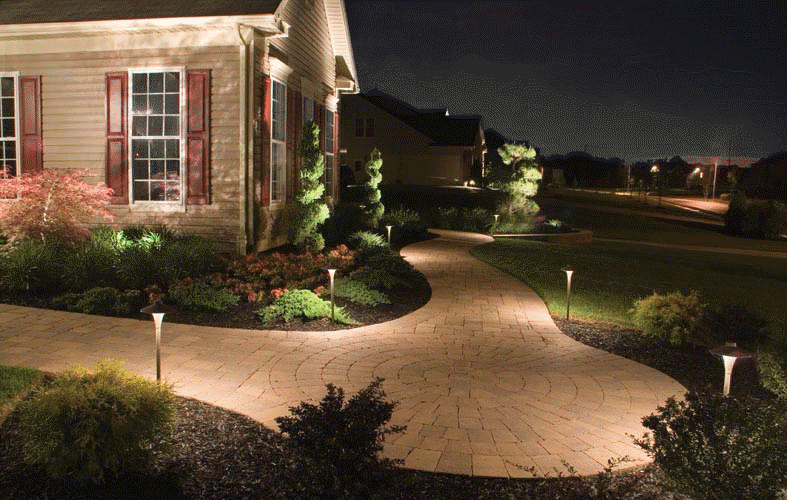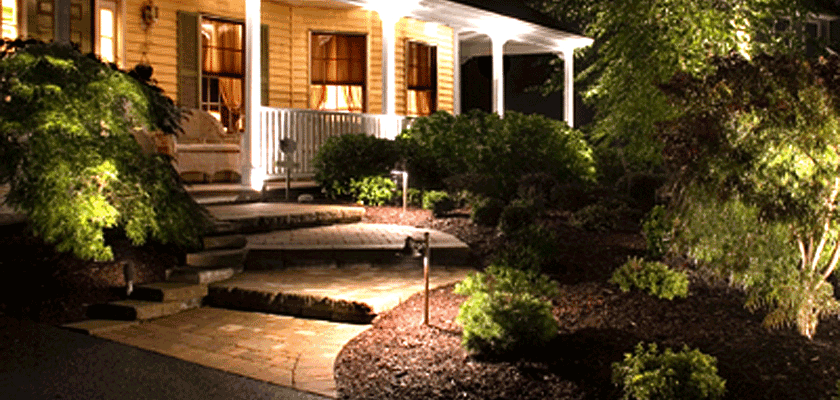Low Voltage Lighting Offers Versatility, Style in Landscaping
St. Louis Landscaping and Low Voltage Lighting
Low-voltage landscape lighting is an afterthought for most homeowners, but professional landscapers consider it one of the most important elements in the landscape. “We use lighting for three purposes,” says Tory Catanzaro, owner of Environmental Landscaping in St. Louis, MO. “To create atmosphere, provide safety by repelling burglars or vandals, and to light the way on paths, patios, and other places we spend time in the landscape.” Here are the facts and usages of low voltage landscape lighting and how to use it effectively:
Lighting can provide a combination of subtle downlighting for ambience and bold uplighting for flair gives depth to this landscaped area. Underwater lighting can be used to highlight a waterfall.
 Up until 2010, the majority of landscape contractors were using halogen lights, which provide a warm glow and great quality of light. However, with the recent advances in LED lighting, most landscape contractors in St. Louis and across the country have converted their operations to energy-efficient LEDs.
Up until 2010, the majority of landscape contractors were using halogen lights, which provide a warm glow and great quality of light. However, with the recent advances in LED lighting, most landscape contractors in St. Louis and across the country have converted their operations to energy-efficient LEDs.
The obvious benefits are those of cost and maintenance savings over time. LED bulbs generally have a 10-year warranty so you rarely need to replace them, and the monthly cost to run is much less than halogen. They’re eco-friendly, which has become a top concern of many customers.
LED bulbs also have a very crisp light that really brings out the features of a home or landscape. LED bulbs are available in warm white, white, and cool white (though the majority steer away from this bluish tone, most suitable to very modern architectural designs). We generally use warm white bulbs.
LEDs are easier to install than halogens, and you can use more lights on a run, or even use a smaller transformer which saves money. It takes a lot less wiring and labor time to install LEDs. LED bulbs also stay cool, which means you can nestle a plant next to your LED fixture without worrying about burning the foliage, something not possible with halogens.
Most of the cons of LED landscape lighting that you may have heard of are in the past. LEDs have come leaps and bounds in the last couple of years in terms of quality of light and fixtures.
These days, low voltage lighting is quite versatile and allows for much variation. With low voltage lights, you can use a wider variety of light bulbs and therefore get a wider variety of beam size. There are also more kinds of lenses with low voltage light fixtures too, giving you more control over the kind of light being cast.
The reason you can use smaller light fixtures with low voltage lighting is that the lower voltage allows for the use of a smaller filament, which means you can use smaller light bulbs, and this creates more options for fitting light fixtures in smaller spaces.
The previous LED bulbs of the past were just the cold bluish-white mentioned above; now the bulbs are available in much warmer tones that feel much more welcoming in the landscape. There are many manufacturers who now offer very well-designed, professional-grade fixtures that last well in the landscape.
LED bulbs do cost about $30, while halogens cost just $6. But the ease of installing LEDs means that the higher cost balances out in labor savings, and halogen lights might need to be replaced yearly; LEDs last 10 years. Choosing LEDs over halogen will also save you 60-70% of your energy costs each month. You can use a dimmer to save energy, which gives you control over your lighting levels, and this has both aesthetic and financial benefits.
In a new landscape, once you have a written landscaping plan it’s easy for a professional like Environmental Landscaping to recommend some high-impact locations for lighting. Some of the best locations will be specific to your particular landscape, but there are a few common places that work well when lit.
Uplighting into trees creates bold shadows in the landscape, a very dramatic effect, while downlighting from the top of a tree mimics the romantic effect of moonlight. Every landscape also has its own unique features. Old twisting trees, spiky plants or water features are all candidates for dramatic lighting.
Bold architectural features are another good selection for lighting, putting the focus on your home. Pillars, stone and veneer, especially at your front entry, all make beautiful shadows and cast indirect light into the landscape.
If budget doesn’t allow for a full lighting installation throughout your plants and gardens, you can either break the project into two stages, or just choose a few key locations to light. If you’d like to install lighting now but need to start small, there are a few areas to focus on.
First, functional areas always come first, like pathways and patios. Pathway and step lights are called “traverse” lighting, because it helps you get from one place to another. Lighting that runs along the path or is embedded under or in the sides of steps works well in this case to ensure safety.
The other most functional spot for lighting is on decks and around patios. This is called “converse” lighting, the type that allows you to enjoy conversation and company. When you chat with friends, you want to be able to see them! Enjoy your deck at night and improve visibility (and safety) with low voltage LED deck lights. We can light the tops and sides of posts, rails and the deck itself. Attractive lighting that surrounds the patio accomplishes the same goal.
 In addition to desirable locations for low voltage lighting in St. Louis homes, there are also some that rarely require it. For example, there is little need to light a driveway; we all have headlights. However, a good alternative here is to light the landscape that goes alongside the driveway.
In addition to desirable locations for low voltage lighting in St. Louis homes, there are also some that rarely require it. For example, there is little need to light a driveway; we all have headlights. However, a good alternative here is to light the landscape that goes alongside the driveway.
We also suggest that even if you can’t afford lighting right now, you should at least pre-wire it so you can install later, so Environmental won’t have to dig up your sod and the beautiful landscape that we create for you. When your landscape dug up during the construction phase, it takes very little effort to run wiring throughout. Once you lay sod and your shrubs have filled in, digging up the landscape to add wire takes a lot more time and money. Therefore we encourage people 100% to pre-wire.
With tips and more that we can provide you, you’ll enjoy a green, beautiful lawn and landscaping even in the heat of summertime. And we are getting close to preparation for the fall season, with more tips on the way!
Environmental Landscaping provides lawn care and landscape services to the entire St. Louis city and county area, in places St. Charles, Oakland, St. Louis City, Soulard, University City, Olivette, Fenton, Manchester, Webster Groves, Glendale, Rock Hill, Brentwood, Kirkwood and Ladue…and everywhere in between!
Call us today 636-225-3848 to learn more about the services we provide, and to schedule a time for us to come out to take a look and give you our professional opinion!
Or you can always get through to us by visiting our Contact Us page and sharing some of the details up front.
Thanks,
Tory Catanzaro, Owner – Environmental Landscaping









